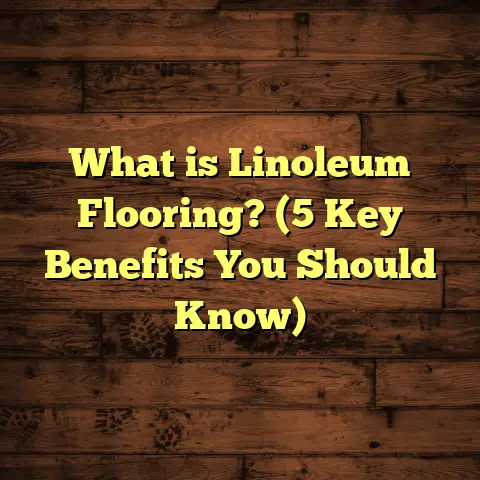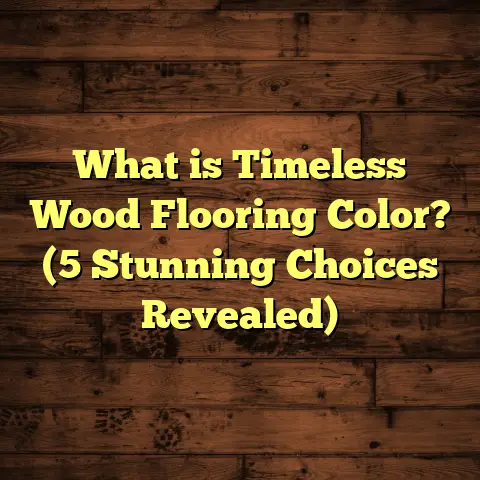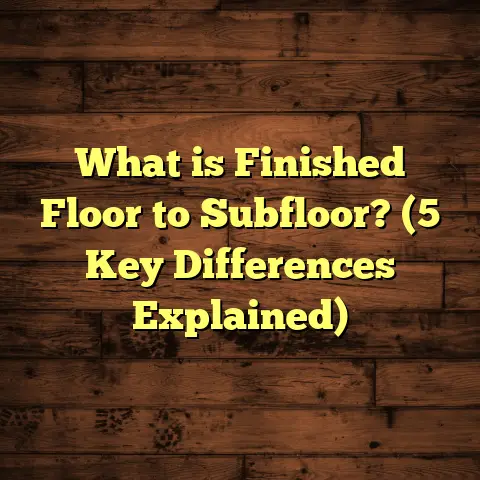What is a Cheap Floor Covering for a Closet? (5 Budget-Friendly Options)
Have you ever stopped to think about what kind of floor covering makes the most sense for a closet, especially when you want to keep costs low? You might assume closets don’t need much thought because they’re small and often hidden spaces. But I’ve learned through years of work that closets aren’t just afterthoughts — the flooring there can affect your whole home’s look and function. Plus, picking the right budget-friendly option can save you time, money, and frustration.
I remember early in my career working on a renovation project where the homeowner wanted to splurge on gorgeous hardwood floors throughout the house but left the closets bare plywood. It looked jarring and unfinished. Worse, because the plywood wasn’t sealed or protected, moisture from shoes and damp clothes started to cause damage. That experience stuck with me—and made me realize that closets deserve their own smart flooring solutions without breaking the bank.
Let’s explore what cheap floor coverings for closets really mean, dig into some technical details behind popular options, and share some of my own experiences and insights to help you pick the right one.
What Is a Cheap Floor Covering for a Closet?
When we talk about “cheap floor covering” for a closet, we’re not just focusing on price alone. It means finding materials that are affordable but still durable, aesthetically acceptable, and easy to install and maintain. A closet floor covering is basically the material layer installed over the subfloor—the foundation beneath your floors—to create a finished surface.
Closet floors get less foot traffic than other rooms but still face unique challenges. Shoes bring dirt and moisture, boxes and storage containers add weight, and sometimes spills happen from laundry baskets or sprays. So the floor needs to withstand wear while being inexpensive enough for such a small area.
Technical meaning of cheap in this context: Materials with a low upfront cost per square foot, low installation labor costs (or DIY friendly), minimal maintenance over time, and reasonable durability suited to light-to-moderate use.
Closet floor coverings vary widely—from wood and carpet to vinyl and laminate—but not all are budget-friendly. For example, solid hardwood floors are beautiful but expensive and overkill for closets. So I’ll focus on options that provide the best balance of price, performance, and ease of installation.
How Flooring Materials Are Made: A Quick Look Behind the Scenes
Understanding how these budget-friendly floor coverings are manufactured helps explain why some cost more than others and what kind of wear they can handle.
- Vinyl Sheet Flooring is created by layering PVC resins with plasticizers to make flexible sheets. The manufacturing process includes calendering (rolling layers thin under heat and pressure), then printing a decorative design layer on top sealed by a protective wear layer. The result is water-resistant, elastic flooring that comes in large rolls or sheets.
- Peel-and-Stick Vinyl Tiles are similar but come as smaller squares with an adhesive backing applied during manufacturing. They often undergo UV curing to harden the surface and improve durability.
- Laminate Flooring consists of multiple fused layers. The core is High-Density Fiberboard (HDF), made by compressing wood fibers with resin under heat and pressure. On top is a photographic design layer (usually wood grain) coated with a tough melamine wear layer that resists scratches. The bottom layer balances moisture absorption.
- Carpet Tiles are tufted or woven from synthetic fibers like nylon or polyester attached to backing materials such as PVC or rubber to provide grip and stability.
- Plywood or OSB Painted Floors involve wood sheets made by gluing layers of wood veneer or wood strands together under heat and pressure. These subfloors provide a base that can be painted and sealed for durability.
Now that we have a solid definition and some background on how cheap floor coverings are made, let me share five budget-friendly options I’ve tested many times.
1. Vinyl Sheet Flooring: Affordable and Practical
Vinyl sheet flooring is one of my favorite budget options for closets because it’s affordable, easy to clean, and surprisingly durable.
What Makes Vinyl Sheet Flooring Work So Well?
The manufacturing process creates a waterproof sheet that can be as thin as 1.5 mm or thicker for commercial use up to 3 mm. The flexibility allows it to conform to uneven subfloors better than rigid materials like tile or hardwood.
The top protective layer often contains urethane or aluminum oxide particles embedded in clear resin. This gives it excellent scratch resistance compared to basic vinyl floors from decades ago.
Cost Breakdown
Material costs typically fall between $0.75 to $2 per square foot depending on quality and design complexity. Installation materials like adhesive add about $0.50 per square foot if you hire someone or slightly less if DIY.
Installation Insights
Installing vinyl sheet flooring in closets is challenging but doable for someone handy with tools:
- The subfloor should be clean, dry, smooth, and level.
- You need special vinyl adhesive spread evenly with a trowel.
- After laying the sheet, a roller ensures proper adhesion.
- Vinyl seams can be heat-welded or chemically sealed for moisture resistance (optional in closets).
Personal Story
A client once wanted an affordable alternative to hardwood for his walk-in closet adjacent to his bedroom. He was on a tight budget but wanted something that matched his style. We chose a wood-look vinyl sheet with a light oak pattern. It gave the closet a warm feel without costing hundreds of dollars. After 4 years, it still looks great despite heavy shoe traffic.
Pros & Cons
| Pros | Cons |
|---|---|
| Waterproof | Requires adhesive installation |
| Easy to clean | Seams can be tricky to seal |
| Affordable | Can dent under heavy furniture |
| Quiet underfoot | Limited lifespan compared to wood |
2. Peel-and-Stick Vinyl Tiles: DIY-Friendly and Versatile
If you want something even easier than vinyl sheets, peel-and-stick vinyl tiles might be your best bet.
How Are They Made?
These tiles are made by extruding PVC vinyl with printed decorative layers topped by UV-cured wear layers for scratch resistance. The pressure-sensitive adhesive on the back allows simple installation by peeling off the liner and pressing onto clean subfloors.
Why I Recommend Them for Closets
- No glue spreading or special tools needed.
- You can replace damaged tiles individually without tearing up the whole floor.
- Patterns range from classic checkerboards to natural stone or wood looks.
- Water-resistant surface good for shoe storage areas.
Costs
Material prices range from $1 to $3 per square foot depending on brand and design quality.
Installation Tips
- Clean the subfloor thoroughly; any dirt reduces adhesion.
- Warm the tiles slightly for better flexibility.
- Press firmly along edges to avoid lifting.
- For best results, stagger tile patterns as you lay them.
Case Study
I helped a landlord renovate several rental units cheaply using peel-and-stick tiles in closet interiors. Tenants appreciated the fresh look, and when tiles wore out after about 7 years, replacements were simple—a huge cost saver.
Pros & Cons
| Pros | Cons |
|---|---|
| Super easy installation | Adhesive can fail in high humidity |
| Replaceable tiles | Not as durable as glued options |
| Water-resistant surface | Limited lifespan in heavy-use areas |
| Variety of designs | Can peel up if not installed properly |
3. Laminate Flooring: Stylish Yet Affordable
Laminate flooring is often overlooked for closets because people assume it’s expensive or complicated. But I’ve installed it in many closets where budget allowed for a more upscale finish.
Manufacturing Details
Laminate starts with HDF core boards which are compressed wood fibers bonded tightly with melamine resins. This core supports the printed decor layer—often realistic wood grain—and is topped by a transparent melamine wear layer that resists scratches and stains.
The click-lock system allows floating installation over underlayment pads without nails or glue.
Why Laminate Works Well Here
- Durable against scuffs from shoes.
- Looks like real wood at a fraction of the cost.
- Easy to clean surface.
- Provides consistent aesthetic flow if closet opens directly into rooms with laminate or hardwood floors.
Price Point
You can find laminate flooring starting around $1.50 per square foot going up to $4 depending on thickness (7mm-12mm) and brand. Installation by homeowners is feasible if you have patience and proper tools.
My Experience With Laminate Closets
When renovating my own bedroom closet recently, I chose laminate flooring because I wanted it to match my bedroom floor without spending too much. It took me about 4 hours over a weekend to install about 60 square feet myself. The result was seamless and gave my closet a polished look that made it feel more like an extension of my bedroom than an afterthought.
Pros & Cons
| Pros | Cons |
|---|---|
| Realistic wood appearance | Sensitive to moisture |
| Durable wear layer | Requires level subfloor |
| Easy DIY installation | Can be noisy without proper underlayment |
| Affordable compared to hardwood | Susceptible to swelling if wet |
4. Carpet Tiles: Softness Meets Affordability
Carpet tiles aren’t usually my first thought for closets but they have unique appeal when comfort underfoot or warmth is desired.
Manufacturing Process
Carpet tiles are tufted or woven from nylon or polyester fibers attached firmly to a backing made of PVC or rubber compounds that prevent slipping.
The tiles come with peel-and-stick adhesive backing or require glue-down installation depending on product type.
Benefits Specific to Closets
- Soft cushioned feel under your feet.
- Absorbs sound—good if your closet has glass doors or is near bedrooms.
- Damaged tiles can be replaced individually.
- Affordable options exist around $1-$3 per sq ft.
Maintenance Considerations
They do require regular vacuuming and occasional spot cleaning but resist staining better than wall-to-wall carpets due to their modular nature.
My Take
I installed carpet tiles in a client’s nursery closet where warmth was important because it connected directly to the child’s room floor. The softness was noticeable every time they stepped in, making it cozy without breaking the budget.
Pros & Cons
| Pros | Cons |
|---|---|
| Soft feel | Requires upkeep |
| Easy replacement | Can trap dust if not cleaned |
| Warmth | Not water-resistant |
| Variety of colors/designs | Shorter lifespan than hard surfaces |
5. Painted Plywood or OSB Floors: Creative Budget Hack
If you want the absolute lowest upfront cost combined with creativity, consider painting plywood or OSB sheets directly over your subfloor inside closets.
How It Works
Plywood or OSB panels—made by gluing wood veneers or strands under heat—are sanded smooth then coated with multiple layers of floor-grade paint plus polyurethane sealer for protection.
This method transforms rough wood into an affordable yet durable floor surface.
Why You Might Choose Painted Wood Floors
- Costs pennies compared to traditional flooring.
- Totally customizable with colors or stencil designs.
- Tough finish especially with polyurethane top coats.
- Ideal for utility closets, laundry areas, or storage spaces where heavy-duty floors aren’t necessary.
Cost Breakdown
Paint plus sealant supplies usually run under $1 per square foot total including primer, paint, brushes/rollers, and polyurethane finish coats.
Installation Notes
- Preparation is key: sand well for smoothness.
- Apply primer first.
- Use 2–3 coats of paint for full coverage.
- Seal with 2–3 coats polyurethane (water-based preferred inside).
- Let each coat dry fully before next application.
My Experience With Painted Floors
I did this in my garage workshop closet where I store paints and tools. It took time due to drying between coats but cost less than $50 total for 40 square feet. It’s held up well despite occasional drips of chemicals and heavy storage boxes.
Pros & Cons
| Pros | Cons |
|---|---|
| Lowest upfront cost | Time-consuming prep/paint work |
| Customizable color/design | Requires repainting every few years |
| Durable if sealed properly | Surface can chip if abused |
| Eco-friendly options available | Not suitable for wet areas |
Comparing These Options Side-by-Side
Here’s an extended comparison based on durability, cost, ease of installation, maintenance, aesthetic appeal, and lifespan for closet applications:
| Floor Covering | Cost per Sq Ft | Durability (Years) | Installation Difficulty | Maintenance Level | Aesthetic Versatility | Notes |
|---|---|---|---|---|---|---|
| Vinyl Sheet | $0.75 – $2 | 10 – 15 | Medium | Low | Moderate | Best waterproof choice |
| Peel-and-Stick Tiles | $1 – $3 | 5 – 10 | Easy | Low | High | Great DIY option |
| Laminate | $1.50 – $4 | 15+ | Medium | Medium | High | Looks upscale |
| Carpet Tiles | $1 – $3 | 5 – 8 | Easy | Medium | Moderate | Adds warmth |
| Painted Plywood/OSB | <$1 | 3 – 7 | Hard (prep intensive) | Medium | High (customizable) | Cheapest; creative option |
More Tips From My Experience
Subfloor Prep Cannot Be Skipped
Many people overlook this step when installing cheap closet floors but trust me—it’s critical for longevity.
If your subfloor has bumps or gaps, vinyl sheets wrinkle; laminate planks don’t lock properly; tiles peel prematurely; painted floors chip faster.
I always recommend sanding rough plywood surfaces smooth before installing anything new. Clean up dust and vacuum debris before laying floors.
Moisture Matters More Than You Think
Closets near bathrooms or laundry rooms may face higher humidity levels that affect some materials:
- Avoid laminate if moisture exposure is likely; it swells easily.
- Vinyl is waterproof but seams must be sealed well.
- Carpet tiles absorb moisture so choose synthetic fibers resistant to mold.
- Painted floors require good sealing coats.
When I worked on an older home renovation near a laundry closet, we tested moisture levels before choosing flooring—vinyl sheet won out because it handled damp conditions best without damage after years of use.
Frequently Asked Questions About Cheap Closet Flooring
Q: Can I install these floor coverings myself?
A: Absolutely! Many options like peel-and-stick tiles, laminate with click-lock systems, carpet tiles, even vinyl sheets (if patient) are DIY-friendly with basic tools.
Q: How long can I expect cheap flooring in closets to last?
A: Depending on material quality and care—anything from 5 years (carpet tiles) up to 15+ years (laminate/vinyl) is possible.
Q: Will cheap flooring make my closet look cheap?
A: Not at all! With good design choices (patterns/textures/colors), budget flooring can look stylish and complement adjoining rooms well.
Q: How do I clean these floors?
A: Sweep/vacuum regularly; use manufacturer-recommended cleaners; avoid soaking laminate/painted floors with water.
Wrapping Up My Thoughts On Budget Closet Flooring
After working with dozens of homeowners on closet renovations—some on shoestring budgets—I’ve realized you don’t need expensive materials to get great results. What matters more is matching your choice to your space conditions (moisture? traffic?), aesthetic goals (warm? sleek?), skill level (DIY or pro?), and long-term plans (replace often or few times).
Vinyl sheets offer waterproof durability at great prices; peel-and-stick tiles make weekend installs easy; laminate adds value with wood-like looks; carpet tiles bring softness; painted plywood floors give you ultimate control at rock-bottom costs.
If budgets get tight but you want your closet floor done right—think through these options carefully. And if you want help picking one based on your specific situation, feel free to ask me anytime!
If you want me to include more specific installation guides step-by-step for each option or detailed case studies with photos from actual projects I completed—just let me know!





